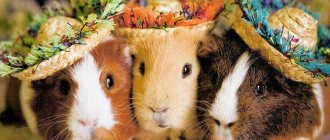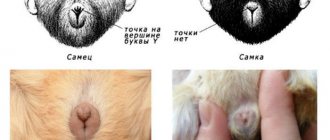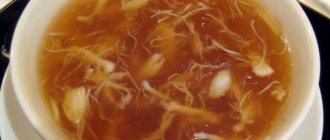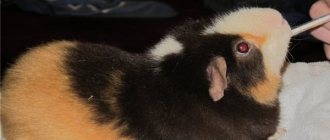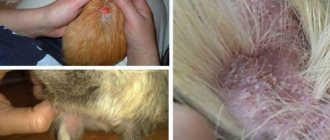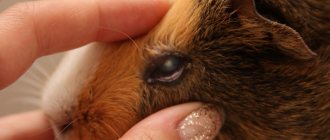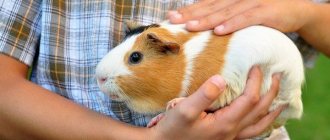Guinea pigs are very friendly and affectionate, ideal pets for a child. However, we must remember that they are also susceptible to disease, like any other living creature. Every happy owner of this cute creature must know all the symptoms of diseases to which guinea pigs are susceptible. We hope that after reading this article you will know more about the ailments that can befall such a fragile and cute guinea pig. Let your pets avoid guinea pig diseases
How can you tell if your guinea pig is sick?
Guinea pigs, which many keep as pets, naturally have strong immunity, resistance and almost complete immunity to viral and bacterial diseases. With proper care and favorable conditions, cute, funny animals can live from 8 to 12 years. But still, do not forget that, like any other living beings, guinea pigs can become infected with any infection or disease. How to understand that an animal is sick?
A healthy pet has beautiful shiny fur, a good appetite, clean, clear eyes, and an expressive look. The animal is active, shows interest in the world around it, and responds adequately to external stimuli.
You can tell that a guinea pig is sick by its changed behavior and characteristic manifestations. The main symptoms of viral, bacterial, parasitic diseases:
- decreased activity, drowsiness, lethargy, depression;
- discharge from the nose, eyes;
- sudden weight loss;
- poor appetite, refusal of favorite treats;
- deterioration of coat condition;
- the presence of wounds, ulcers, abrasions, scratches, abscesses on the body;
- shortness of breath, cough, sneezing, difficulty breathing;
- change in heart rate;
- diarrhea, constipation;
- frequent urination;
- impaired coordination of movements;
- trembling, convulsions, muscle spasms;
- increased thirst;
- change in consistency, color, character of stool;
- change in behavior (lethargy, anxiety, aggression).
A guinea pig suffering from demodicosis.
A sick pet becomes inactive, depressed, tries to hide in secluded places in the cage or constantly sits in its house. The pig refuses food, does not take care of its hygiene, and does not respond to external stimuli.
Any of the above signs or a combination of them should alert owners. If your guinea pig is sick, your pet's condition worsens; you should not self-medicate. Some infections have an aggressive course and can cause the death of your beloved pet. In addition, some animal diseases are transmitted to people (rabies, tuberculosis, pasteurellosis), so if the animal gets sick, consult a veterinarian. The specialist will make a diagnosis and select effective treatment.
Infectious diseases
Infectious diseases are caused by viruses, bacteria, and simple pathogenic microorganisms. A guinea pig can become infected from other pets, its relatives, or latent virus carriers. Infection occurs predominantly by contact, airborne droplets, and nutritional routes. Intrauterine infection is possible, in which the fetuses become infected in the womb.
Viral-bacterial infections diagnosed in guinea pigs can develop against the background of hypo-vitaminosis, stress, unbalanced feeding, due to a decrease in immune potential, resistance.
Plague
Plague is a deadly infection for guinea pigs. Characterized by lightning-fast development and high mortality. The incubation period lasts from several days to 3 weeks.
Symptoms:
- indigestion;
- diarrhea, vomiting;
- mucous, purulent discharge from the eyes;
- lethargy, apathy, drowsiness;
- lack of coordination;
- slight trembling;
- seizures, convulsions;
- pallor of mucous membranes.
Unfortunately, no treatment has been developed for this infection, and the guinea pig is euthanized.
Pseudotuberculosis
The disease is characterized by high mortality, aggressive course, digestive disorders, shortness of breath, and difficulty breathing. At autopsy, small dense nodules are found in the internal organs, which resemble tuberculous tubercles. Infection occurs through the nutritional route.
Main symptoms:
- profuse diarrhea;
- weight loss;
- lack of appetite;
- drowsiness, lethargy, depression;
- deterioration of coat;
- profuse discharge from the eyes and nose;
- dirty, wet fur near the anus;
- convulsions.
Feces have a watery consistency, contain mucus, foam, bloody substances, and emit a sharp, specific odor. In the early stages, if you start treatment, you can save and cure your pet. Broad-spectrum antibiotics and sulfonamides are used in therapy.
Paratyphoid
Infection can be transmitted through food and water contaminated with bacteria. The disease occurs in acute, subacute, and less commonly, chronic form. Main symptoms: tousled fur, loss of appetite, sudden weight loss, green diarrhea, drowsiness, depression, inactivity.
When diagnosing paratyphoid fever, the treatment for a guinea pig will be determined by a veterinarian. The animal is prescribed complex antibacterial drugs, tetracycline antibiotics, homeopathic remedies, antityphoid serum, sulfadimezin. Medicines are given with food or dissolved in water.
Lymphocytic choriomeningitis
A fairly common disease in guinea pigs, which often causes the death of pets. The disease progresses at lightning speed. The duration of the incubation period ranges from 35–42 hours to 5–6 days. In rare cases, the infection becomes latent.
In sick animals, the temperature rises, regional lymph nodes enlarge, and coordination of movements is impaired. The pet becomes inactive and refuses to eat. Once the diagnosis is confirmed in the laboratory, the guinea pig is euthanized.
Bordetellosis
As a rule, guinea pigs become infected through direct contact with other pets. Dogs, cats, rodents can be carriers of a dangerous virus. The disease is manifested by changes and disturbances in the functioning of the respiratory tract and is characterized by shortness of breath, frequent shallow breathing, cough, profuse catarrhal-serous discharge from the nose and eyes, conjunctivitis, and lethargy. A sick pig throws its head to the side, rubs its muzzle with its paws, shows anxiety and can become aggressive. Appetite is reduced or completely absent.
Treatment for a guinea pig should be comprehensive. Antibacterial agents, sulfonamides, complex symptomatic, and restorative drugs are used in therapy. Good results are noted after intramuscular administration of Baytril and Gentamicin (4–5 mg/kg). The dosage and duration of the course will be prescribed by your veterinarian.
Pasteurellosis
The infection is manifested by general depression, weakness, lack of appetite, increased thirst, tearfulness, and sneezing. Near the nose, the fur is moist due to abundant mucous or purulent discharge. The guinea pig is rapidly losing weight and breathing heavily. When auscultating the sternum, murmurs are clearly audible. The fur becomes brittle and matte. Ulcers appear on the body in various places. If the inflammatory process extends into the deep layers of the dermis, blood poisoning is possible.
The disease can last for months and periodically worsen under the influence of concomitant unfavorable factors due to decreased immunity. Treatment has not been developed, and the pig dies due to intoxication, exhaustion, and sepsis.
Diseases caused by parasites
Invasive diseases in guinea pigs are caused by external and internal parasites. Infection occurs through contact and nutritional routes. The most common diagnoses for guinea pigs include worms, fascioliasis, and coccidiosis.
Fascioliasis
The disease is caused by parasitic liver fluke worms. The disease is manifested by lethargy, apathy, drowsiness, yellowness of the skin and mucous membranes, and signs of intoxication. Sick pets completely refuse water and food, quickly lose weight, and look severely exhausted.
Unfortunately, this pathology manifests itself in the later stages of the development of the disease, after autopsy, so fascioliasis is detected in most cases posthumously. To prevent the development of the disease, several times a year for preventive purposes you need to give your pets anthelmintic drugs (Praziquantel), strictly adhering to the dosage indicated in the instructions.
Coccidiosis
The disease is caused by single-celled parasites - Eimeria from the genus Coccidia. Young animals with an immature or weakened immune system are at risk. Adult animals develop immunity to a certain type of coccidia.
A characteristic symptom is indigestion (diarrhea followed by constipation, vomiting, lack of appetite). The feces contain mucus, foam, and particles of undigested food. In advanced cases, bloody spots may be seen in the stool.
In sick pets, diuresis increases, which can be understood by the bedding quickly becoming contaminated with feces. Animals lose weight and are severely depressed. Mucous membranes are pale, cyanotic. The abdomen is increased in volume. The fur near the anus is wet, dirty, and matted. When palpating the peritoneum, the animals experience severe discomfort and pain.
Having noticed the first symptoms, put your pet in another cage; if the animal is kept in a pair, contact a veterinarian who will tell you how to treat this disease. Ditrim, Furazolidone, Himcoccid, Sulfadimezin are used in therapeutic therapy. Medicines are added to drinking water in recommended dosages.
External parasites, skin diseases
Among external parasites, a guinea pig can be infected with fleas, lice eaters, and ticks. Ectoparasites provoke flea dermatitis and allergies. Parasitic diseases are manifested by anxiety, nervousness, severe itching, and sleep disturbances. On the body you can notice a rash, red small spots, hairless areas, dandruff, scratching. The coat becomes dull and loses its natural shine.
Skin diseases in guinea pigs require an integrated approach. The choice of drugs depends on the form, stage, and cause of dermatological pathologies.
Pets are prescribed insecticide-acaricidal drops, antiparasitic shampoos, ointments, and antibiotic-based liniments. In addition to the main treatment, the diet is adjusted and the cage is disinfected.
Peeling skin is a symptom of ectoparasite infection
How to create additional comfort for an animal
A dying guinea pig needs even more care than usual. Therefore, it is important to try to brighten up her last days of life. How to help a rodent before death:
- It is better to leave the dying animal in a cage with other guinea pigs if they do not harm it. These animals love to be in company. In isolation, the rodent will be bored.
- A dying guinea pig's heart beats slower and its circulation is impaired, so it gets cold. To help her warm up, you need to put a soft, warm cloth in the cage. It is advisable to place the animal’s home in a warm place and ensure that the bedding always remains dry.
- Shortly before death, the animal is so weak that it can no longer independently approach the feeder and drinker. In the last days of his life, he will have to be given food from a spoon or an insulin syringe. It is advisable to grind the food and mix it with a small amount of water. If your pet doesn't want to eat, you don't need to force it.
- A dying pet is much calmer when it feels the love and care of its owner. You should approach the cage more often and stroke the pig’s head. There is no need to pick her up every time so as not to cause pain.
- Let the animal die in peace. It is advisable to place the cage in a quiet room. The lighting should not be too bright. It is necessary to protect the pig from everything that prevents it from feeling safe.
- If the rodent has a favorite thing or toy, it is better to put it in the cage. It will help you calm down.
Non-communicable diseases
Diseases of non-infectious etiopathogenesis pose no less danger to the health and life of guinea pigs. A deficiency of nutrients leads to metabolic disorders, rickets, hypo- and avitaminosis, and provokes digestive problems and hormonal imbalances.
The main symptoms of rickets and vitamin deficiency:
- disturbances in growth and development;
- poor coat condition;
- thickening of joints;
- sagging back;
- curvature of limbs;
- impaired coordination of movements;
- convulsions, muscle spasms, paralysis;
- nervous disorders, increased excitability.
If a pig suffers from rickets, hypo-vitaminosis, or vitamin deficiency, the animals are prescribed multivitamin complexes and mineral-vitamin mixtures. Add 2-3 drops of Tetravit and Trivitamin to drinking water daily. Adjust the diet.
Hypothermia and stress weaken the body and can cause not only respiratory ailments, but also cystitis, stone disease, and other pathologies of the excretory system.
Avitaminosis
With cystitis or inflammation of the bladder, urination becomes more frequent, pets become inactive, and hide in secluded places in the cage. Mucous membranes are anemic, pale. Urine takes on a brown, red-brown hue. Upon detailed examination, you can see bloody threads, clots, and fibrin flakes in the urine. Treatment is carried out with antibiotics, antispasmodics, sulfonamides, and homeopathy. The veterinarian will select treatment depending on the underlying cause.
In older animals, benign and malignant neoplasms are detected. If the cancer has not metastasized and is characterized by a benign course, surgical treatment is prescribed in which the tumor is removed.
Due to injury, animals receive various injuries in fights with relatives. A fall from a height can cause deep wounds, fractures, ruptures, sprained ligaments and tendons.
For wounds and ulcers, drugs for local treatment are prescribed (ointments, gels, liniments, pharmaceutical mash), antiseptic solutions, suspensions, as well as symptomatic drugs to normalize the general condition.
For purulent abscesses, ulcers, wounds, Vishnevsky's liniment and streptomycin ointment are applied to the affected areas. Before applying the drug, the hair near the lesion is cut off. The damaged surface is treated with an antiseptic (hydrogen peroxide), foreign objects are removed, crusts and scabs are removed. After applying the ointment, apply a fixing bandage.
Lichen
Another very unpleasant and dangerous disease, the causative agent of which is a fungus. Ringworm affects the hair follicle and skin.
Signs
The presence of lichen can be determined by several signs:
- in the affected areas, the fur falls off and red, encircling spots appear;
- the skin peels and constantly itches and hurts;
- the appearance of rough, sometimes raised spots on the skin;
- the skin may become scabby;
- the animal is constantly itching.
Kinds
If lichen is not treated, the probability of infection in healthy pigs is almost 100%. There are two types of lichen, which most often affect these particular pets:
- microsporia;
- trichophytosis.
Spores of these fungi can be active for 2-3 years. They are stored in soil, wool and are distributed safely in the environment. Most often, animals with weak immunity and living in unsanitary conditions are susceptible to infection with lichen.
To detect the fungus, a thorough examination is carried out - shining the affected area under a UV lamp and taking skin scrapings in areas of peeling.
Treatment
Sick animals are moved to a separate cage. By completely sterilizing the home and all its accessories. In affected areas, the hair is completely cut off.
To treat lichen, antifungal medications for guinea pigs are used - Chlorhexidine, Clotrimazole, Miconazole. As veterinary practice shows, there are no better drugs today, since the positive effect of treatment is achieved quite quickly.
Gastrointestinal diseases
The development of diseases of the digestive system is facilitated by poor-quality nutrition, an unbalanced diet, and a deficiency of vitamins, macro-, and microelements. Pathologies can occur against the background of viral, bacterial, parasitic infections and diseases (helminthic infestations, poisoning).
An unbalanced diet and exposure to toxins provoke food allergies and severe poisoning. Gastrointestinal diseases in guinea pigs are manifested by unstable stool (diarrhea, constipation), weakness, lethargy, decreased appetite, refusal of favorite treats, vomiting, weight loss, and decreased activity.
Stomach upset in mumps
Helminths, which can live in the intestines, liver, lungs, heart, liver, pancreas, disrupt metabolic processes, interfere with the absorption of nutrients, poison the body with toxins, provoke disturbances in the functioning of internal organs and systems, and can cause seizures and convulsions. A piglet infested with worms can die from a nervous attack, severe exhaustion, severe intoxication, or intestinal blockage.
Treatment and the choice of methods depend on the form, stage of the disease, and the root cause. Animals are prescribed absorbents, restoratives, symptomatic medications, antibiotics, enzymes, probiotics, homeopathic remedies, and decoctions of medicinal plants. For diarrhea, Fthalazol, Enterosgel, Enterosperol are prescribed. You can give your pet rice water or strong tea. Flax seed, chamomile tea, and herbal infusions will help normalize digestion.
Pseudotuberculosis
Pseudotuberculosis is a chronic disease.
It is characterized by the appearance of nodular formations on the diseased organs and tissues.
An animal is infected through food: pseudotuberculosis is caused by a bacillus called bact. pseudotuberculosis rodentium .
Symptoms:
- decreased appetite;
- exhaustion;
- diarrhea;
- paralysis.
Treatment
Be sure to hospitalize your mumps. Treatment is strictly inpatient .
Eye diseases in guinea pigs
Keratitis, conjunctivitis, uveitis, corneal ulcers, entropion, inflammation of the eyelids are ophthalmological diseases often diagnosed in guinea pigs. They can be congenital or occur due to mechanical damage, trauma, as well as secondary infections and diseases.
When the mucous membranes of pigs become inflamed, the eyes fester and the eyelids swell. Animals are afraid of bright light, become restless or, conversely, very depressed and inactive. Due to abundant mucous, catarrhal, purulent discharge, the fur on the face is constantly wet. Dry crusts appear near the eyes or in the corners. In severe cases, clouding of the cornea, decreased visual function, and complete or partial blindness are noted.
Corneal lesion
Symptoms depend on the cause, form, localization of the pathological process or inflammation. Treatment is carried out comprehensively. They are used for general and local treatment. The conjunctiva is washed with disinfectant solutions. Medicinal anti-inflammatory and antibacterial drops are instilled into the eyes, and medicinal ointments (tetracycline, chloramphenicol) are applied.
If the eye disease is caused by an infection, the sick pet is prescribed antibiotic therapy. Systemic antibiotics of complex action are used. Treatment of guinea pigs is carried out until complete recovery and normalization of general condition.
Pasteurellosis
The main symptom of this disease is a runny nose.
Symptoms
Primary – the hairs around the nostrils are moisturized.
Secondary – sneezing appears.
The animal sneezes and rubs its nose area with its front paws.
The condition of the respiratory system is severe, with wheezing.
Over time, mucus and pus are released from the nose.
The duration of the illness is several months. It may subside for a while and worsen.
A guinea pig in a severe stage of pasteurellosis will have to be euthanized .
Treatment
There is no specific disease; pasteurellosis is practically incurable .
Ear diseases
If the guinea pig shakes its head, constantly rubs its muzzle with its paw, has become inactive, a large amount of wax and dark crusts are noticeable inside the ear, you can suspect that the pet has otitis media. The disease can be caused by mites, viruses, bacteria, fungi, or foreign objects entering the ear canal that cause inflammation.
With otitis media, the temperature rises. The inner surface of the auricle is hyperemic and inflamed. A sharp, specific smell emanates from the ears. On the outer surface you can see wounds, scratches, scratches. With bilateral otitis, the guinea pig becomes lethargic, stretches its neck forward or tilts its head to the side. When examining the ear, redness and severe pain are noted. Dry dark crusts, scabs, and ulcers are visible inside the ear.
Otitis media is very often complicated by pathogenic flora and can cause deterioration, partial or complete loss of hearing function, so treatment must be started immediately.
Animals are prescribed antibacterial medicinal drops, solutions, lotions, and symptomatic medications for general treatment. Before instillation of the ear, the ear canal is cleaned of contamination using antiseptics, and crusts and wax are carefully removed with a sterile cotton-gauze pad. All manipulations are carried out very carefully to avoid damage to the eardrum. Topical medications are instilled into each ear of the pet.
Rickets
The development of this disease is caused by a lack of vitamins or minerals in the rodent's body. At each stage of this disease, different symptoms appear. First, the animal experiences gastrointestinal upset, then a desire to eat inedible foods and objects appears - bedding, calla lilies, soil, lime.
Externally, this disease can manifest itself as follows:
- hunched over;
- paws are bent;
- joints thicken;
Guinea pigs suffering from rickets are noticeably retarded in growth and development.
The greatest likelihood of developing rickets is observed at a young age, with a monotonous diet. The most favorable season is winter. Since it is during this period that the required amount of fruits and vegetables required by the young body is missing.
Animals suffering from rickets are placed separately from healthy animals. During the treatment period they are given trivitamin or trivit. Irradiation procedures are carried out with a quartz lamp (10 sessions of 10 minutes each). Fish oil (vitamin D and A concentrate) is added to dry food.
Respiratory system diseases
Respiratory diseases in guinea pigs develop due to decreased immunity, severe hypothermia, and exposure to drafts. They are manifested by general weakness, lethargy, impairment, depression of respiratory function, coughing, sneezing, fever, chills, fever, purulent, mucous, catarrhal discharge from the eyes. Animals are inactive and react sluggishly to external stimuli.
Treatment must be prescribed by a veterinarian
During treatment, owners must strictly follow all recommendations of the treating veterinarian. Before giving your pet medication, carefully read the instructions for the medication. Stick to the indicated dosage. During treatment, as well as after treatment, carefully monitor the behavior and health of your pet.
We invite you to join our Zen channel and group on VKontakte or Odnoklassniki, where new articles for pet owners are published.
Similar articles:
- The simplest things that can harm a guinea pig
- Djungarian hamster at home: advice for the future owner
- How to organize leisure time for a guinea pig?
